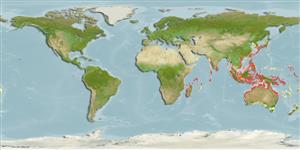Teleostei (teleosts) >
Anguilliformes (Eels and morays) >
Muraenidae (Moray eels) > Muraeninae
Etymology: Gymnothorax: Greek, gymnos = naked + Greek, thorax, -akos = breast (Ref. 45335).
More on author: Richardson.
Environment: milieu / climate zone / depth range / distribution range
Ecology
Marine; reef-associated; depth range 3 - 30 m (Ref. 90102). Tropical
Indo-West Pacific: Mauritius and the Comoros to the west Pacific.
Size / Weight / Age
Maturity: Lm ? range ? - ? cm
Max length : 180 cm TL male/unsexed; (Ref. 48635)
Recognized by its generally more white color and smaller and rounder spots (Ref. 48635).
Solitary among coral outcrops, often seen protruding head from shelter. Found in coastal reefs and outer slopes in 3-30 m (Ref 90102).
Life cycle and mating behavior
Maturity | Reproduction | Spawning | Eggs | Fecundity | Larvae
Böhlke, E.B., J.E. McCosker and D.G. Smith, 1999. Muraenidae. p. 1643-1657. In K.E. Carpenter and V.H. Niem (eds.) FAO species identification guide for fishery purposes. The living marine resources of the Western Central Pacific. Vol. 3. Batoid fishes, chimaeras and bony fishes part 1 (Elopidae to Linophrynidae). FAO, Rome. (Ref. 12904)
IUCN Red List Status (Ref. 130435: Version 2024-2)
Threat to humans
Harmless
Human uses
Fisheries: minor commercial
Tools
Special reports
Download XML
Internet sources
Estimates based on models
Preferred temperature (Ref.
123201): 21.4 - 29.2, mean 28.3 °C (based on 2688 cells).
Phylogenetic diversity index (Ref.
82804): PD
50 = 0.5000 [Uniqueness, from 0.5 = low to 2.0 = high].
Bayesian length-weight: a=0.00048 (0.00025 - 0.00091), b=3.28 (3.12 - 3.44), in cm total length, based on LWR estimates for this Genus-body shape (Ref.
93245).
Trophic level (Ref.
69278): 4.3 ±0.7 se; based on size and trophs of closest relatives
Resilience (Ref.
120179): Very Low, minimum population doubling time more than 14 years (Preliminary K or Fecundity.).
Fishing Vulnerability (Ref.
59153): Very high vulnerability (90 of 100).
